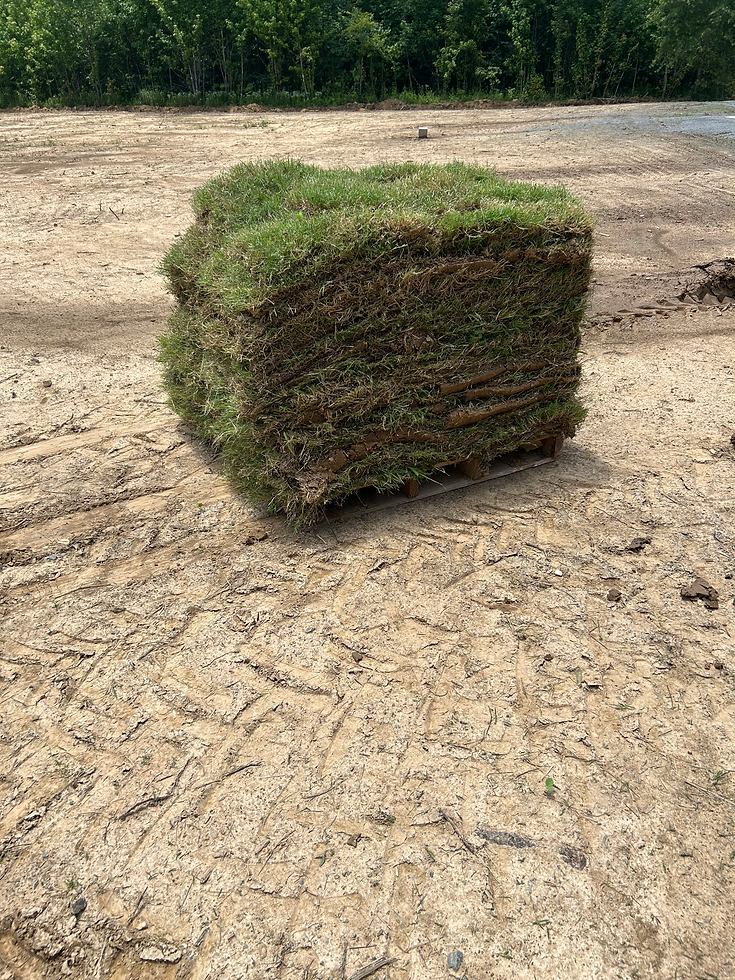
Arkansas guide to Sod
- Garrett Williams
- Jul 1
- 4 min read
How to Make the Perfect Yard: From Topsoil Dressing to Laying New Sod
A beautiful, vibrant lawn is often the focal point of a well-landscaped yard. If you want a lush green yard that stands out, you need to give it the proper care it deserves, starting with the soil. Topsoil dressing is an essential part of that preparation process, creating an ideal environment for your new sod to take root. Here’s how you can do it step by step.
1. Start with a Clean Slate
Before you begin any soil preparation or laying sod, you need to clear the area. Remove any weeds, dead grass, or debris like rocks and sticks. It’s also a good idea to check for uneven spots or areas that are lower than others. If you notice large dips or mounds, use a shovel or rake to level the ground as best as possible.
2. Loosen the Soil
Now that you have a clean and relatively flat surface, it's time to prepare the soil. The top 2-4 inches of soil need to be loosened so that your topsoil dressing can properly penetrate. You can do this using a garden fork, a hoe, or a tiller if you’re working with a large area. This step helps to aerate the soil, making it easier for grass roots to establish themselves later on.
3. Apply Topsoil Dressing
Topsoil dressing is essentially a thin layer of high-quality soil spread over your existing soil. It helps fill in low spots, improves soil texture, and adds important nutrients. Here’s how you can apply it:
Choose the Right Topsoil: Opt for a high-quality, screened topsoil that is free of contaminants like weeds and debris. Some topsoils are enriched with organic matter, which is a good choice for promoting healthy grass growth.
Spread Evenly: Using a shovel or a broadcast spreader, evenly spread a thin layer (about 1/4 to 1/2 inch) of topsoil across the entire area. Make sure the layer is uniform, as you don’t want it to be too thick in some spots and too thin in others. If you have areas where the soil is especially compact or the ground is uneven, you can apply a bit more in those spots.
Rake and Smooth: After spreading the topsoil, use a rake to level it out and create a smooth, even surface. This will help ensure good soil contact when you lay your sod down later.
4. Fertilize (Optional but Recommended)
If your soil is nutrient-poor, now’s a good time to add some fertilizer to give your new sod a boost. Choose a balanced fertilizer with nitrogen, phosphorus, and potassium (NPK). Follow the instructions on the package, as applying too much can lead to fertilizer burn, which can harm your lawn.
5. Lay the New Sod
Now comes the exciting part—laying down the new sod. Choose a variety of sod that is appropriate for your climate and soil conditions. If you’re unsure, consult with a local garden center or sod supplier for advice on the best type for your area.
Here’s how to properly lay sod:
Stagger the Joints: Lay the sod pieces in a brick-like pattern, staggering the seams between rows to prevent long seams that can create weak spots.
Fit the Edges Together: Lay each piece tightly next to the next, making sure there are no gaps. Gaps can dry out and cause weak areas in the grass later on.
Trim Edges: If necessary, trim the edges of the sod to fit around landscaping elements or corners using a sharp utility knife or garden shears.
6. Water, Water, Water
One of the most important steps after laying sod is proper watering. Immediately after you lay the sod, water it thoroughly to ensure the topsoil is moist and the sod begins to establish roots.
Over the next few weeks, water your new sod deeply but infrequently to encourage deep root growth. Early morning is the best time to water, as it allows the grass to dry out during the day and prevents diseases caused by excessive moisture. Aim to water once a day during the first week, then reduce it to every other day for the next two weeks. After that, you can start transitioning to deeper, less frequent watering sessions.
7. Give it Time and Care
After laying your sod and watering it properly, the next step is to give it time to root. It can take a few weeks for the sod to establish itself, and during that time, it’s crucial to continue regular watering. As the grass begins to take root, you can start mowing when the grass reaches about 3-4 inches in height. Mow your lawn to a height of about 2-3 inches, but avoid cutting more than one-third of the grass height at once.
8. Maintain and Enjoy Your Lawn
Once your new sod is rooted and growing strong, it’s time for routine maintenance. Regular mowing, occasional fertilization, and watering will keep your lawn looking its best. Watch out for weeds, pests, and diseases, and treat them as necessary to keep your lawn healthy.
Final Thoughts
Creating the perfect yard is about more than just laying sod—it’s about preparing the soil to give your new grass the best possible start. Using topsoil dressing is a crucial step in this process, as it helps improve soil quality, ensures better root growth, and sets the foundation for a vibrant lawn. With proper care and maintenance, your new sod will flourish, giving you a lush, green yard that’s the envy of the neighborhood.
Happy gardening!




Comments